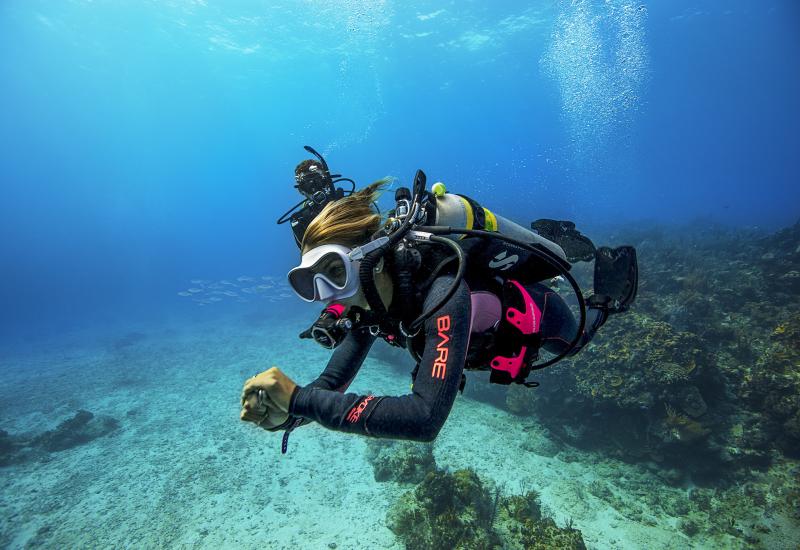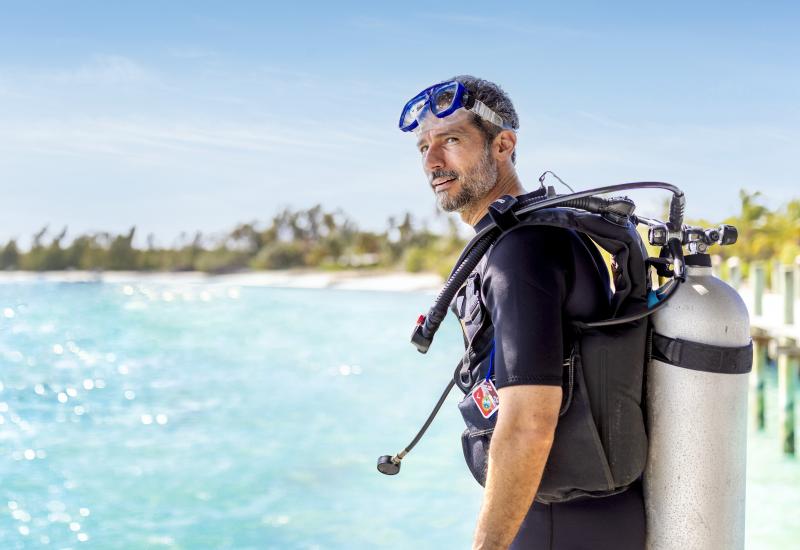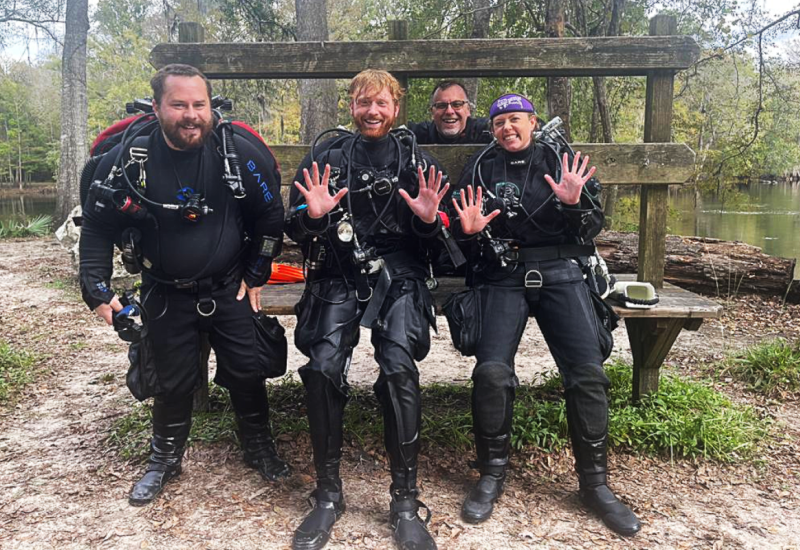Rebreathers 101
 |
| Semi-closed nitrox rebreathers aren't as complicated as they look and cost about the same as a complete set of high-end scuba gear. |
November 2003
By Michael Ange
Photography by Chris Jaffe
An open-water diver asked me recently why anyone would want to dive with a rebreather. The question surprised me. Who wouldn't want the comfort, ease and the access to marine life that only a rebreather can provide?
As we talked, I realized that this diver was a victim of several common misconceptions about recreational rebreathers--that they're too expensive, too complicated, that you have to be a rocket scientist to make sense of a dive system that's equal parts black magic and high tech.
Wrong, wrong and wrong. In fact, semi-closed nitrox rebreathers are no more expensive than a top-quality scuba system, are easily used by recreational divers, and use basic technology that dates back to the 1800s. With the proper training, any diver worthy of his open-water C-card can handle a semi-closed rebreather--no voodoo or advanced degree required.
Keep It Simple
Many divers have confused recreational semi-closed rebreathers with the cutting-edge closed-circuit rebreathers favored by the military and hard-core tech divers. The two systems are about as different as a single-engine Cessna is from an F-18. Both work on the same general principles, but the simplicity of the semi-closed systems makes them the logical choice for recreational pursuits.
By way of explanation, let's review those general principles. Since the 1600s, explorers knew they could extend a diver's time under water by recirculating his breath, and since the 1870s they have been devising ways to do it. The science is simple: When we inhale a breath of air, we take in a mixture of approximately 21 percent oxygen and 79 percent nitrogen. When we exhale that same breath, the oxygen content is around 16 or 17 percent, the difference in gas volume being made up of carbon dioxide. All but about four or five percent of that exhaled air is reusable.
A rebreather has two functions: remove the carbon dioxide and replace the consumed oxygen. Most divers immediately worry about the oxygen, but in reality the most important task is removal of carbon dioxide. A diver will die from hypercapnia (carbon dioxide poisoning) much more rapidly than he will from hypoxia (lack of oxygen).
This reaction has two interesting and beneficial by-products--heat and water vapor. Once the breath is scrubbed, it flows into a counter-lung or breathing bag where the oxygen is replenished. When the diver inhales again, he gets a warm, moist and properly oxygenated breath.
The Difference
Replenishing the oxygen is where rebreather systems can get complicated. Some advanced closed-circuit systems use multiple computer-controlled oxygen sensors that require careful preparation and monitoring.
On the other hand, semi-closed rebreathers are very simple. A pre-mixed gas, typically nitrox, is continuously added to the breathing loop in a very small measured dose--imagine a controlled leak that constantly flows gas into the breathing bag. The flow rate is based on a simple mathematical calculation of the amount of oxygen the diver typically uses. If any electronics are used in semi-closed systems, they are simple monitoring devices that tell the diver the partial pressure of oxygen in the breathing loop.
Semi-closed rebreathers do allow some gas to escape throughout the course of a dive. Despite this occasional venting of breathing gas, most divers can count on between 90 and 180 minutes of dive time on a single cylinder of less than 30 cubic feet depending on the gas used. The final limitation compared to the more complicated closed-circuit designs is a 165-foot depth limit due to nitrox operating limits.
The Advantages
Most divers who try rebreathers do so in order to get closer to marine life. The acoustic and pressure waves of exhaled bubbles can be a huge impediment to marine life interaction. Dolphins, sharks and whale sharks are all notoriously skittish around bubble-blowing divers. I can tell you from personal experience, however, that the occasional small stream of breathing gas vented from a semi-closed rebreather has no effect on hammerhead sharks and other marine life.
The warm, moist breathing air of a rebreather is also a physiological advantage. The thermal stress caused by breathing cold compressed air is fairly dramatic. Divers will frequently find themselves diving in much thinner wetsuits and much colder water than they would attempt in open-circuit gear. The moist air also prevents dry mouth, and both of these factors lessen diver fatigue.
Rebreather divers also enjoy the freedom of movement made possible by a truly lightweight, one-piece breathing unit, but the real advantages semi-closed rebreather systems have over open-circuit scuba systems are cost, ease of use and weight. There are several semi-closed systems that, when completely configured and ready to dive, weigh less than a standard 80-cubic-foot cylinder. A fully capable semi-closed system includes everything to replace your BC, regulator, pressure gauge, octopus and cylinder.
The Learning Curve
You do need to complete a special certification class to use a semi-closed rebreather because the experience of using one is quite unlike open-circuit scuba.
For starters, the dynamics of breathing on a rebreather are different. As you get comfortable diving the rebreather, you will notice that the loudest sound you hear is the sound of gas entering your lungs. No mechanical valves opening, no metallic clicks of first stage seats and no hiss of high-pressure air. Unlike breathing on open-circuit regulators, high-pressure air is not shoved down your throat with every breath. Breathing under water becomes as natural as breathing on the surface.
The next thing divers notice is the need to retune buoyancy control. Because the air from the lungs is shifted to the counter lung during exhalation, there is no change of buoyancy like that experienced during exhalation on traditional gear. Rebreather divers must be careful on ascent--all that expanding air can bring you to the surface a little quicker than expected if you don't take the proper steps to slow your ascent. Most semi-closed systems have a built-in buoyancy compensator that works just like a traditional BC.
Finally, there is training in maintenance. Recreational semi-closed systems can be assembled almost as quickly as open-circuit gear. There are a few additional steps, such as filling the scrubber canister and checking the gas flow through the system with a small flow meter provided by the manufacturer. Just like with your open-circuit gear, you also have to check the unit for leaks prior to the dive. Disassembly is a bit more complex for some people, especially if you're like most divers and don't properly clean your open-circuit gear. Washing and disinfecting the breathing loop is required after every day of diving to prevent infections, mold and mildew from growing in the breathing loop, but this added step takes the average rebreather diver less than 10 minutes.
A Few More Questions
> IS IT SAFE? For properly certified divers using brand name products, semi-closed rebreathers have one of the best safety records in our sport. Just be sure to get the proper training. The average semi-closed unit course requires about four to five academic hours and four open-water dives.
> IS IT EXPENSIVE? Not when compared to a full set of top-quality scuba gear. For under $2,000, you can buy a semi-closed nitrox rebreather that serves all the functions of a BC, regulator, pressure gauge, octopus and cylinder. The daily cost of diving a rebreather on a typical two-tank charter is pretty close to the cost of diving open-circuit nitrox. The cost to fill the scrubber canister is about $10, and you'll need one nitrox fill for the 30-cubic-foot supply tank. Both will easily last for two dives at recreational depths. If you are diving for the weekend, some units have a enough scrubber capacity for both days of diving (four-plus hours of bottom time), driving your cost down to about 65 percent of the open-circuit nitrox.
> IS IT WORTH THE EFFORT? No matter where you dive, there are many benefits to semi-closed rebreather use for recreational divers: warmer, more comfortable dives in cooler climates; relaxing on the bow while everyone else changes tanks between dives; the best video and photos you've ever taken of marine life; and let's not forget the "oohs" and "aahs" you'll hear from others on the boat.
> WHAT TRAINING DO I NEED? The standard prerequisites for a semi-closed rebreather course are open-water certification and basic nitrox certification. Some training agencies require advanced open-water certification. You'll also need to have between 25 and 50 logged dives.
Courses are offered through:
American Nitrox Divers International (ANDI), (516) 546-2026; web: www.andihq.com.
International Association of Nitrox & Technical Divers (IANTD), (305) 751-4873; web: www.iantd.com.
National Association of Underwater Instructors (NAUI), (800) 553-6284 or (813) 628-6284; web: www.nauitec.com.
Professional Association of Diving Instructors (PADI), (800) 729-7234 or (949) 858-7234; web: www.padi.com.
Technical Divers International (TDI), (888) 778-9073; web: www.tdisdi.com.
|| |---|
|
| | Semi-closed nitrox rebreathers aren't as complicated as they look and cost about the same as a complete set of high-end scuba gear.|
November 2003
By Michael Ange
Photography by Chris Jaffe
An open-water diver asked me recently why anyone would want to dive with a rebreather. The question surprised me. Who wouldn't want the comfort, ease and the access to marine life that only a rebreather can provide?
As we talked, I realized that this diver was a victim of several common misconceptions about recreational rebreathers--that they're too expensive, too complicated, that you have to be a rocket scientist to make sense of a dive system that's equal parts black magic and high tech.
Wrong, wrong and wrong. In fact, semi-closed nitrox rebreathers are no more expensive than a top-quality scuba system, are easily used by recreational divers, and use basic technology that dates back to the 1800s. With the proper training, any diver worthy of his open-water C-card can handle a semi-closed rebreather--no voodoo or advanced degree required.
Keep It Simple
Many divers have confused recreational semi-closed rebreathers with the cutting-edge closed-circuit rebreathers favored by the military and hard-core tech divers. The two systems are about as different as a single-engine Cessna is from an F-18. Both work on the same general principles, but the simplicity of the semi-closed systems makes them the logical choice for recreational pursuits.
By way of explanation, let's review those general principles. Since the 1600s, explorers knew they could extend a diver's time under water by recirculating his breath, and since the 1870s they have been devising ways to do it. The science is simple: When we inhale a breath of air, we take in a mixture of approximately 21 percent oxygen and 79 percent nitrogen. When we exhale that same breath, the oxygen content is around 16 or 17 percent, the difference in gas volume being made up of carbon dioxide. All but about four or five percent of that exhaled air is reusable.
A rebreather has two functions: remove the carbon dioxide and replace the consumed oxygen. Most divers immediately worry about the oxygen, but in reality the most important task is removal of carbon dioxide. A diver will die from hypercapnia (carbon dioxide poisoning) much more rapidly than he will from hypoxia (lack of oxygen).
This reaction has two interesting and beneficial by-products--heat and water vapor. Once the breath is scrubbed, it flows into a counter-lung or breathing bag where the oxygen is replenished. When the diver inhales again, he gets a warm, moist and properly oxygenated breath.
The Difference
Replenishing the oxygen is where rebreather systems can get complicated. Some advanced closed-circuit systems use multiple computer-controlled oxygen sensors that require careful preparation and monitoring.
On the other hand, semi-closed rebreathers are very simple. A pre-mixed gas, typically nitrox, is continuously added to the breathing loop in a very small measured dose--imagine a controlled leak that constantly flows gas into the breathing bag. The flow rate is based on a simple mathematical calculation of the amount of oxygen the diver typically uses. If any electronics are used in semi-closed systems, they are simple monitoring devices that tell the diver the partial pressure of oxygen in the breathing loop.
Semi-closed rebreathers do allow some gas to escape throughout the course of a dive. Despite this occasional venting of breathing gas, most divers can count on between 90 and 180 minutes of dive time on a single cylinder of less than 30 cubic feet depending on the gas used. The final limitation compared to the more complicated closed-circuit designs is a 165-foot depth limit due to nitrox operating limits.
The Advantages
Most divers who try rebreathers do so in order to get closer to marine life. The acoustic and pressure waves of exhaled bubbles can be a huge impediment to marine life interaction. Dolphins, sharks and whale sharks are all notoriously skittish around bubble-blowing divers. I can tell you from personal experience, however, that the occasional small stream of breathing gas vented from a semi-closed rebreather has no effect on hammerhead sharks and other marine life.
The warm, moist breathing air of a rebreather is also a physiological advantage. The thermal stress caused by breathing cold compressed air is fairly dramatic. Divers will frequently find themselves diving in much thinner wetsuits and much colder water than they would attempt in open-circuit gear. The moist air also prevents dry mouth, and both of these factors lessen diver fatigue.
Rebreather divers also enjoy the freedom of movement made possible by a truly lightweight, one-piece breathing unit, but the real advantages semi-closed rebreather systems have over open-circuit scuba systems are cost, ease of use and weight. There are several semi-closed systems that, when completely configured and ready to dive, weigh less than a standard 80-cubic-foot cylinder. A fully capable semi-closed system includes everything to replace your BC, regulator, pressure gauge, octopus and cylinder.
The Learning Curve
You do need to complete a special certification class to use a semi-closed rebreather because the experience of using one is quite unlike open-circuit scuba.
For starters, the dynamics of breathing on a rebreather are different. As you get comfortable diving the rebreather, you will notice that the loudest sound you hear is the sound of gas entering your lungs. No mechanical valves opening, no metallic clicks of first stage seats and no hiss of high-pressure air. Unlike breathing on open-circuit regulators, high-pressure air is not shoved down your throat with every breath. Breathing under water becomes as natural as breathing on the surface.
The next thing divers notice is the need to retune buoyancy control. Because the air from the lungs is shifted to the counter lung during exhalation, there is no change of buoyancy like that experienced during exhalation on traditional gear. Rebreather divers must be careful on ascent--all that expanding air can bring you to the surface a little quicker than expected if you don't take the proper steps to slow your ascent. Most semi-closed systems have a built-in buoyancy compensator that works just like a traditional BC.
Finally, there is training in maintenance. Recreational semi-closed systems can be assembled almost as quickly as open-circuit gear. There are a few additional steps, such as filling the scrubber canister and checking the gas flow through the system with a small flow meter provided by the manufacturer. Just like with your open-circuit gear, you also have to check the unit for leaks prior to the dive. Disassembly is a bit more complex for some people, especially if you're like most divers and don't properly clean your open-circuit gear. Washing and disinfecting the breathing loop is required after every day of diving to prevent infections, mold and mildew from growing in the breathing loop, but this added step takes the average rebreather diver less than 10 minutes.
A Few More Questions
> IS IT SAFE? For properly certified divers using brand name products, semi-closed rebreathers have one of the best safety records in our sport. Just be sure to get the proper training. The average semi-closed unit course requires about four to five academic hours and four open-water dives.
> IS IT EXPENSIVE? Not when compared to a full set of top-quality scuba gear. For under $2,000, you can buy a semi-closed nitrox rebreather that serves all the functions of a BC, regulator, pressure gauge, octopus and cylinder. The daily cost of diving a rebreather on a typical two-tank charter is pretty close to the cost of diving open-circuit nitrox. The cost to fill the scrubber canister is about $10, and you'll need one nitrox fill for the 30-cubic-foot supply tank. Both will easily last for two dives at recreational depths. If you are diving for the weekend, some units have a enough scrubber capacity for both days of diving (four-plus hours of bottom time), driving your cost down to about 65 percent of the open-circuit nitrox.
> IS IT WORTH THE EFFORT? No matter where you dive, there are many benefits to semi-closed rebreather use for recreational divers: warmer, more comfortable dives in cooler climates; relaxing on the bow while everyone else changes tanks between dives; the best video and photos you've ever taken of marine life; and let's not forget the "oohs" and "aahs" you'll hear from others on the boat.
> WHAT TRAINING DO I NEED? The standard prerequisites for a semi-closed rebreather course are open-water certification and basic nitrox certification. Some training agencies require advanced open-water certification. You'll also need to have between 25 and 50 logged dives.
Courses are offered through:
American Nitrox Divers International (ANDI), (516) 546-2026; web: www.andihq.com.
International Association of Nitrox & Technical Divers (IANTD), (305) 751-4873; web: www.iantd.com.
National Association of Underwater Instructors (NAUI), (800) 553-6284 or (813) 628-6284; web: www.nauitec.com.
Professional Association of Diving Instructors (PADI), (800) 729-7234 or (949) 858-7234; web: www.padi.com.
Technical Divers International (TDI), (888) 778-9073; web: www.tdisdi.com.










